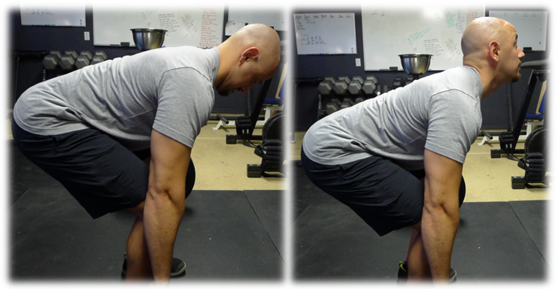So you want to get better at deadlifting?
I can dig it…
On one side of the coin, the deadlift is a brutal test of strength that slabs on pounds of muscle all over your body. It rev’s up your metabolism and turns you into a fat burning machine.
On the other hand, the deadlift can leave you crawling to your cell phone so you can text the first 5 contacts in your phone to take you to the chiropractor.
… It doesn’t have to be like that.
Contrary to popular belief the deadlift isn’t as simple as you might think.
On the outside, it just looks like, “Oh, I just pick this weight up off the floor by standing up?”
On the inside, the deadlift is a technical lift and despite what your local personal trainer with a weekend certification tell you, it is safe when executed properly.
If you are a weekend warrior, competitive powerlifter, washed up meathead, or a PR chasing soccer mom, I guarantee this article will increase your deadlift.
You have to be willing to take some time to learn new techniques, chalk up your hands and put in the work.
How I deadlifted 600lbs without being strong
That’s my official confession to you and it’s true.
Back when I was competing in powerlifting, my biggest deadlift was 600lbs. My best was actually 585 weighing 178 in my last meet.
There’s a reason I’m telling you this and it’s not to brag, in fact, it’s quite the opposite.
Have you ever see those guys are brutally strong without lifting weights? The guys that do manual labor for 10+ hours a day and are strong as an Ox?
I am not that guy. In fact, I am pretty much the exact opposite of that guy.
I only weighed about 10lbs more than my girlfriend when I graduated high school, and she was a tiny girl.
When I started lifting a few years later I was still skin and bones and weak as piss.
Over time I was able to develop a decent level of strength, deadlifted 3.3x my bodyweight in my last meet and 600lbs the meet prior to that.
Impressive to hardcore powerlifting beasts? Absolutely not.
Shocking to people like you and I? Apparently so.
Hold on, I thought you said you weren’t that strong.
I’m not and I’m sticking to that story — I did it by getting really good at these exercises. Not brutally strong. Just really good and technical.
This is what I am going to teach you in this article and these are the things that are only learned from grinding your ass off for years trying to get better at something.
Let’s dive into it…
The 10 Deadlift Commandments
The essential steps necessary to deadlift ‘a metric fuck-ton’, while still staying pain and injury free (that’s a real unit of measurement, right?)
You have to dial in your technique if you want to pull some serious weight.
Although things may look good on the outside, it doesn’t mean you are ready to stand up with heavy-ass weight in your hands.
1. Thou shalt keep their hips high and close
Your hips should be high while maintaining the most leg tension as possible. You also want your hips to be close the bar as well. This does not refer to your hips being closer to the ground (because that would be the opposite of keeping your hips high).
There will be a point when you are wedging yourself into a position where you will feel the most tension in both your hamstrings and quads, this is the best starting position .
You will learn more about wedging later in this article.
Your hip height will be dependent on anthropometrics (femur, tibia, torso, and arm lengths) and your body type.
This will also be a deciding factor whether you will be strongest and most comfortable using a sumo, conventional or a modified sumo stance. A 5’7″ guy with big belly weighing 230lbs with short arms will look different at the start than a 5’11” 118b Victoria Secret model with long legs. This takes a little bit of tinkering and adjusting to find what works best and what you are most comfortable with.
Wherever your hips are when the bar breaks the floor is where you want to have your hips at the start of the lift.
2. Thou shalt become a wedge
A lot of lifters show a great starting position (lower back, upper back, neck, hip, and pelvis) but aren’t tight enough. When they try to lift the weight, they lose position and fold over like a shrimp.
This usually happens because the lifter hasn’t created enough tension and leveraged into a tight starting position. Don’t be a shrimp.
You don’t want to place yourself into the correct position, you want to pull yourself into it. It’s a skill to learn to use the weight of the bar to wedge yourself into the starting position.
- Start your set up by getting your correct foot position
- Hinge at your hips and reach your butt back to the wall behind you. As you hinge back, reach one arm straight down to the bar until you can grab a firm grasp of it with about 60% effort.
- Grab the barbell with your other hand and actively pull yourself into your starting position by keeping as much tension as possible throughout your body (about 20% effort).
- You should already be putting ~80% of your effort into the bar and it’s ready to shoot off like a loaded spring.
If you do this correctly, a weight on the bar that is close to your own weight, should come up off the ground.
The misunderstood cue of ‘pull the slack out of the bar’ is actually in reference to this. Watch how I ‘wedge’ myself between the barbell and floor when I set up for this deadlift. You can notice the bar already bends before I even begin lifting it off the floor.
Using the bar to wedge yourself into a powerful starting position will result in a smooth and strong break off the floor. Without the correct tension, there will be violent jerking movement that usually involves getting the lifter into a poor position and a missed lift.
3. Thou shalt keep their shins vertical
When the weight breaks the floor, you want your shins as close to vertical as possible.
This will not look the same for everyone. It is important to keep in mind that your actual starting position (hip height, torso angle, and shin angle) will look different from other lifters with different limb lengths.
Longer limb lifters probably won’t be able to get into a vertical shin position to start. They will have to a positive shin angle which is fine as long as they follow the other commandments.
In fact, these lifters put themselves at a disservice by forcing themselves into too much of a vertical shin and losing leg drive off of the floor.
4. Thou shalt not blindly copy other lifters
Just because someone is strong or is a good lifter does not mean they know why or what they are doing. Some people are just flat out strong before the even touch a weight.
Watch great lifters and mimic their technique if these lifters have a similar build to you. Time and time again I see people doing things they have no idea why which actually end up being pointless or harmful.
“Why are you reaching up to the sky before you lift?”
I see this a lot and always ask why someone does it, usually it’s because they saw another lifter or coach doing it.
If take a look at Eric Cressey deadlift (whose is one strong ass dude and also one of the best strength coaches out there) you’ll notice him reach up towards the sky before a lift. He isn’t praying to the deadlift gods.
He is reaching up to take a big-ass breath into his diaphragm, brace his arms and lats before he uses the weight of the bar to wedge himself into the tightest starting position he possibly can.
Dan Green does the same thing but in a different way…
If you’re watching a video of other lifters (which you should be because there are a lot of techniques to learn), make sure to look at those who move like you and are roughly the same height, weight and have similar limb lengths.
5. Thou shalt push their shoulders away from their ears
Stand tall with your hands by your sides and retract your shoulder blades as much as possible. What happened?
Your hands raised. If you were holding a heavy ass barbell in your hands you just increased the distance you have to move that bar.That is not the best position you want to be in when you deadlift.
You want to make your arms as long as possible not shorten them. Retracted and depressed shoulders place a lot of unnecessary stress on the shoulder joint and do not provide more strength or stability.
What you actually want to do: Punch your fist down towards the ground and push your hands towards the wall behind you. Now you are locked in and ready to deadlift.
6. Thou shalt keep a neutral neck
Stand against a wall and try to get as tall as you can (like when you had to get your height measured in grade school.) Now, stand up even taller. Pretend like there is a string on the top of your head and someone is pulling it up and stretching you out.
Keep a similar neck position when you are deadlifting. This is often referred to as ‘packed neck’ or a ‘neutral neck’.
You want to set yourself in the correct position from the start of the setup and keep it throughout.
With something like this I always lean to the side of being in a safer position so I like to keep my clients as close to a neutral neck as possible because that is the safest position for them.
For competitive lifters, there’s little leeway and I am ok with slight extension. If you look at experienced lifters you will notice slight neck extension (reaching the head back) and a rounded UPPER back (not lower back.)
When you are experienced you may want to learn how to pull with a rounded upper back (while still keeping the lower back arched), but this is an advanced progression that I don’t recommend for most lifters.
The most important thing is learning how to deadlift with perfect form before anything else. This means having a straight back and neutral neck positioning before even thinking about trying a rounded back deadlift. Which brings us to the 7th deadlift commandment.
7. Thou shalt strengthen, build and practice the deadlift with perfect form
Training is intended as practice and to get us strong at the movement. This happens by reinforcing great form and increasing intensity, volume and or load over a period of time.
Competition and maxes in training can be planned, but you should not be trying a new deadlift max every time you step foot in the gym. This is great if you like injury, overtraining and stagnation. I don’t.
If your deadlifting for general health, to look good or to increase performance in a sport other than powerlifting, avoid maximum-effort attempts.
Start with the correct deadlift variation based on your body type and experience level.
Some lifters don’t even have enough body awareness or mobility to get into a proper deadlift setup so they may have to start with kettlebell deadlifts, block pulls or rack pulls.
You might prefer the conventional deadlift while others feel better in a sumo stance. If you aren’t a competitive powerlifter you can only perform hex-bar deadlifts and get extremely strong with them. It’s possible and completely allowed.
8. Thou shalt use controlled violence
Failed deadlift attempts are usually pulled too slow or too fast and throw the lifter out of a good position. The best deadlifts are lifted with ‘controlled violence’.
By pulling too slow most lifters don’t put enough force into the ground to get a really heavy weight to move and pulling too fast has it’s own set of problems.
Lifting too fast usually results in a failed attempt because there isn’t enough tension created between them lifter and the bar before starting the pull. You will see their hips shoot up and they fall forward OR don’t even budge the weight off the floor.
Your deadlift should look like a rocket ship taking off into space, as opposed to a rubber band being flung.
If you watch a rocket ship take off, it takes a while to build up. There’s lots of shaking, smoke, fire, and noise then all the sudden it lifts off the ground and you know the rest. That’s how you to think of your setup and create as much tension as possible.
Then, let it fly.
9. Thou shalt push first and hump second
The struggle to lock out heavy deadlifts usually due to weak muscles or a breakdown in technique. Typically it is the latter and this can be fixed by adjusting technique.
Trying to fall back with the weight which makes it difficult to not only start the lift but also to lock it out.
“The deadlift is a pull, right? Shouldn’t I just be leaning back really really hard to start the lift?”
Nah, son. This will actually cause you to get stuck at the bottom of the lift because you are in a bad position. Usually, this happens either on the floor or right when the weight break contact with the floor.
Fix this by starting the movement as a leg press and picture yourself pushing the floor away from you. This will create even more tension when added with the other deadlift commandments.
Once the bar reaches the top of your knee cap, push your hips forward to meet the bar. Just try to hump the barbell.
It is basically a standing hip thrust. You have just won at the deadlift.
10. Thou shalt wear proper attire
Your shoes can be the difference between a making or miss a lift. The actual shoes you decide to wear will depend on personal preference, but there are a couple important factors to look for in a good deadlifting shoe.
Thin sole, flat sole, hard sole, stable and balanced
You want a shoe that will allow for a greater transfer of force that is stable, opposed to a soft cushioned shoe that is wobbly and absorbs valuable energy. A soft running or trainer shoe can not only be a huge energy leak but also open up the door for potential injury.
Avoid deadlifting in a shoe with a raised heel. This makes it harder to achieve the vertical shin angle and often pitches lifters forward, which is not a strong position to be in.
Popular deadlift footwear include:
- Deadlift slippers
- Chuck Taylors
- Minimalist shoe (Vibram, Merrell, etc)
- Just your dirty ass socks
Next up is those sexy legs of yours. You need a high pair of socks or leggings. I personally prefer leggings because they keep my ‘wittle leggies’ nice and warm when I am lifting which feels better on my knees. But, you can’t wear these in competition, so that can mentally screw with people prepping for a meet.
If you are deadlifting properly the bar should be close to your body because that is the most advantageous line of pull. This can lead to nasty cuts and bruises on your shins if they aren’t covered.
Wear something to cover and protect them without causing the bar to stick even more.
The more material the greater the friction between your clothing and the bar. Shorts with high socks are the best bet, leggings would be second and pants would be third.
Bonus tip: throw baby powder on your legs to make for an even smoother pull. Have a partner do it so you don’t get it on your hands, because then the bar will just slip out of your hands.
Before You Go, Be Great
Visualization and the ability to rehearse movements in sport is one thing that separates the good from the great. The same goes for the deadlift.
Just like any high-level athlete or businessman, great deadlifters have already completed the task in their head and they know where their body is, what it is going to feel like and already see themselves doing it.
That’s why it’s extremely important to practice how you’re going to compete.
- Be methodical and approach the bar the same every time.
- Use the same setup and the same gear.
- Go over the same mental checklist in your head
- Commit to the lift.
- Get strong as hell.
Enjoy. You can watch me fix Chris’ deadlift in real time here.
-Joey
PS. Post below and let me know what commandment has helped you the most.
DID YOU LIKE THIS POST?
Enter your email to join thousands of bold readers who are on a mission to be, do, and have more.You’ll get my famous daily emails to help you take charge and build a badass body, business, and life.






Optimize Your Farm’s Water Management with Bwer Pipes: Bwer Pipes offers a comprehensive range of irrigation solutions designed to help Iraqi farmers maximize water efficiency. Our reliable sprinkler systems and durable pipes ensure uniform water distribution, promoting healthier crops and sustainable farming practices. Explore Bwer Pipes
Bwer Pipes – Your Trusted Partner for Agricultural Irrigation in Iraq: Explore Bwer Pipes for reliable irrigation solutions tailored for Iraqi agriculture. From durable pipes to advanced sprinkler systems, we have everything you need to optimize your crop yields. Visit Bwer Pipes